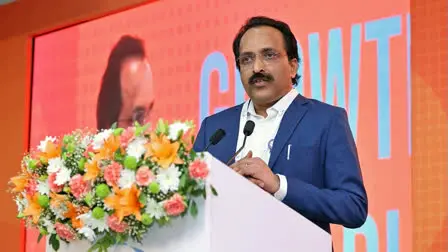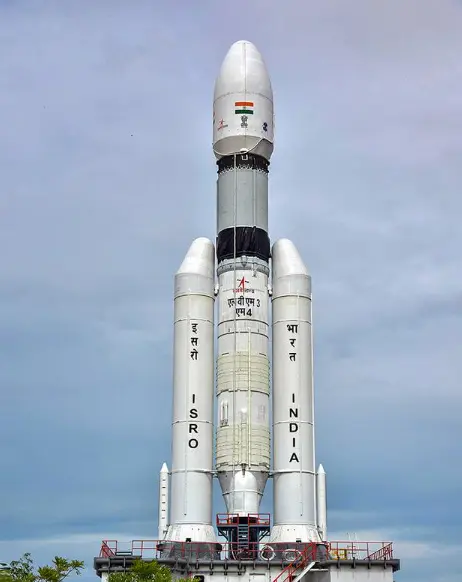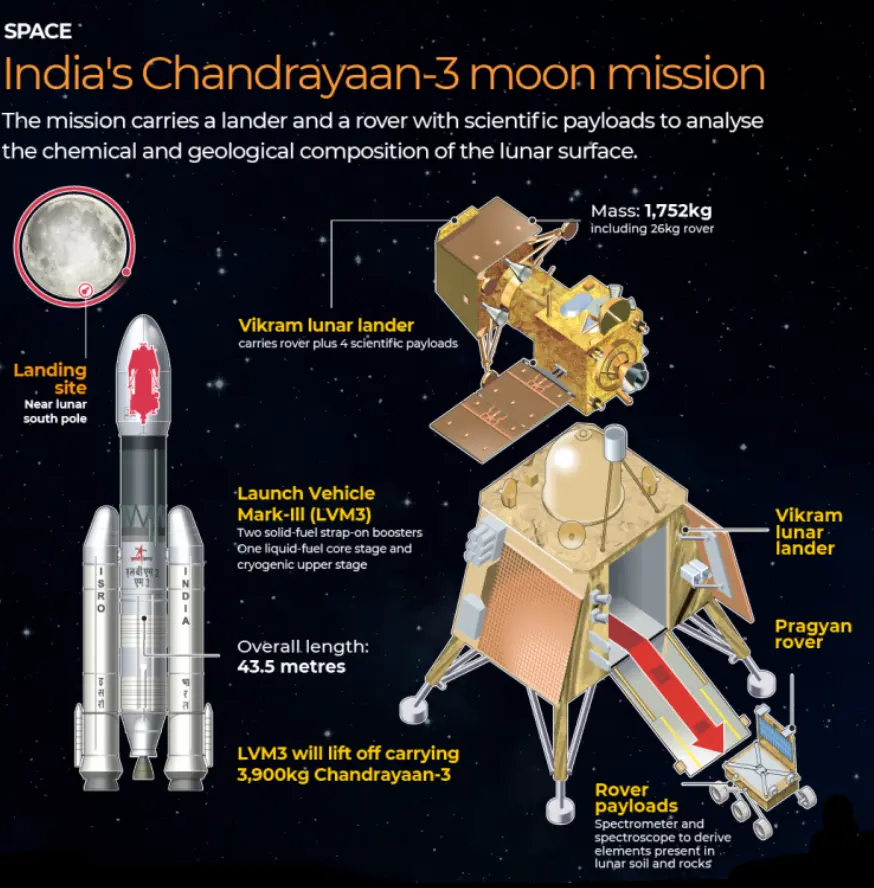ISRO Chairman S. Somanath Honored with IAF World Space Award for Chandrayaan-3’s Historic Achievement
Introduction
On October 14, 2024, the Indian Space Research Organisation (ISRO) Chairman S. Somanath was honored with the prestigious International Astronautical Federation’s (IAF) World Space Award for the outstanding success of Chandrayaan-3. This award highlights the remarkable achievement of India’s space exploration journey and its growing prominence in the global arena. The Chandrayaan-3 mission, which successfully soft-landed near the lunar South Pole, has solidified India’s place as a key player in space science, exploration, and technology.

Chandrayaan-3’s Triumph: Winning the IAF World Space Award and Shaping India’s Space Exploration Journey
The Indian Space Research Organisation's (ISRO) Chandrayaan-3 mission has not only made India proud but also earned international acclaim by winning the prestigious IAF World Space Award. This victory highlights India’s growing dominance in space exploration and sets the stage for a promising future in global space collaborations. Let's explore the significance of the IAF World Space Award, Chandrayaan-3’s achievements, and how this mission has inspired a generation of space enthusiasts in India and across the globe.
IAF World Space Award: A Prestigious Honor in Space Exploration
The International Astronautical Federation (IAF) World Space Award is one of the most coveted accolades in space science. This award recognizes groundbreaking achievements that push the boundaries of space exploration and contribute to humanity’s understanding of the universe. Winning this award places India among the top players in space science and highlights the global respect for ISRO’s achievements.
Previous winners of the IAF World Space Award include renowned missions like NASA’s Apollo 11 and the Hubble Space Telescope. With Chandrayaan-3 now joining this elite group, it solidifies India’s reputation as a leader in cost-effective and successful space missions.
Chandrayaan-3 Mission: A Historic Achievement for India

The Chandrayaan-3 mission will be remembered as a key milestone in India’s space journey. Launched on July 14, 2023, Chandrayaan-3 successfully landed on the lunar South Pole on August 23, 2023. This achievement makes India the first country to land near the lunar South Pole, a region believed to hold critical resources like water ice, which could be vital for future lunar missions.
The journey to this success wasn’t without challenges. Chandrayaan-3 was built upon the lessons learned from Chandrayaan-2, which faced a landing failure in 2019. The improvements in Chandrayaan-3’s lander system, combined with rigorous testing, ensured a smooth landing. Technological advancements, such as improved navigation systems and upgraded software, played a crucial role in overcoming the challenges.
S. Somanath: The Leader Behind Chandrayaan-3’s Success
At the heart of this mission’s success is S. Somanath, the Chairman of ISRO. With years of experience in space exploration, Somanath’s leadership has been a guiding force for the Chandrayaan-3 mission. Under his tenure, ISRO has witnessed remarkable achievements, including Chandrayaan-3’s flawless landing.
Somanath’s vision for India’s space exploration goes beyond just lunar missions. He has expressed his excitement about Chandrayaan-3’s discoveries and believes that India’s success in space will inspire further global collaborations and innovations.
India’s Rising Status in Global Space Science
India’s space journey has been nothing short of extraordinary. From Chandrayaan-1 to the successful Mangalyaan Mars mission, ISRO has consistently demonstrated its ability to achieve high-impact results at a fraction of the cost of other space agencies. Chandrayaan-3’s success has further elevated India’s position in the global space community.
The cost-effectiveness of ISRO’s missions, combined with their high success rate, has made India a key player in space exploration. The global recognition of Chandrayaan-3 by the IAF highlights the impact of India’s achievements and opens doors for future collaborations with other space agencies.
Chandrayaan-3’s Scientific Discoveries: A Leap Forward for Lunar Exploration
Chandrayaan-3’s lander and rover have provided invaluable scientific data, particularly in detecting sulfur and other elements in the lunar soil. The South Pole region of the moon is of particular interest due to its potential water ice deposits, which could support future missions or even lunar bases.
The mission’s discoveries will contribute to global lunar exploration efforts, advancing our understanding of the moon’s composition and its potential for future resource utilization.
Inspiring the Next Generation: Chandrayaan-3’s Impact on STEM Education in India

One of the most profound effects of Chandrayaan-3’s success has been its ability to inspire young minds in India. The mission has sparked interest in STEM (Science, Technology, Engineering, and Mathematics) education and careers, with many students now aspiring to work in space science and engineering.
Space exploration missions like Chandrayaan-3 have the power to shape India’s future technological advancements, and the growing interest in STEM education will fuel the next generation of Indian scientists, engineers, and innovators.
International Collaborations: India’s Role in Global Space Exploration
Chandrayaan-3’s success has opened doors for international collaborations. ISRO has already partnered with agencies like NASA and ESA (European Space Agency) on various missions, and the success of Chandrayaan-3 strengthens India’s position as a valuable partner in future space missions.
Joint lunar or Mars missions could be on the horizon, with India playing a crucial role in global space exploration efforts.
India’s Vision for Future Lunar Missions
ISRO’s future lunar missions don’t stop with Chandrayaan-3. The roadmap for Chandrayaan-4 and beyond includes ambitious plans, such as establishing lunar bases and exploring the potential for resource utilization on the moon. ISRO’s long-term goals also include missions to Mars and beyond, solidifying India’s commitment to space exploration.
Frequently Asked Questions (FAQs)
- What is the Chandrayaan-3 mission, and why is it important?
- Chandrayaan-3 is India’s third lunar mission, launched by ISRO on July 6, 2023, and achieved a soft landing near the lunar South Pole on August 23, 2023. It is significant because it marked India as the first nation to land near the South Pole of the Moon, a region of strategic importance for future lunar exploration.
- What is the IAF World Space Award?
- The IAF World Space Award is a prestigious honor given by the International Astronautical Federation to recognize outstanding contributions to space science, technology, and exploration. It celebrates remarkable achievements in advancing humanity’s knowledge and capabilities in space.
- Why was Chandrayaan-3 chosen for the IAF World Space Award?
- Chandrayaan-3 was chosen for the IAF World Space Award due to its historic achievement of landing near the lunar South Pole, its cost-effective engineering, and its significant contributions to scientific understanding of the Moon’s composition.
- How did S. Somanath contribute to the success of Chandrayaan-3?
- S. Somanath, as the Chairman of ISRO, played a pivotal role in guiding the Chandrayaan-3 mission to success. His leadership helped overcome challenges faced by the previous Chandrayaan-2 mission, ensuring the success of Chandrayaan-3 and advancing India’s space exploration capabilities.
- What scientific discoveries were made by Chandrayaan-3?
- Chandrayaan-3 made several significant discoveries, including the detection of sulfur and other elements in lunar soil. These findings have enhanced our understanding of the Moon’s geology and composition, particularly in the South Pole region.
- What is the significance of landing near the lunar South Pole?
- The lunar South Pole is a region of interest for future space missions due to its potential for water ice deposits, which could be a vital resource for future lunar bases. Chandrayaan-3’s successful landing near this region opens up opportunities for further exploration and utilization of lunar resources.
- What is the future of India’s space exploration program?
- India’s space exploration program, led by ISRO, has ambitious plans for the future, including the Gaganyaan human spaceflight mission and further lunar and interplanetary exploration. ISRO aims to continue pushing the boundaries of space exploration while maintaining its reputation for cost-effective engineering.
Conclusion
The recognition of Chandrayaan-3 by the IAF with the World Space Award is a testament to India’s growing influence in the global space exploration community. Under the leadership of ISRO Chairman S. Somanath, Chandrayaan-3 not only achieved a historic lunar landing but also contributed valuable scientific data that will shape future lunar missions. This mission has inspired a new generation of scientists and engineers in India, boosting interest in STEM fields and establishing India as a key player in shaping the future of space exploration.
India’s journey to the Moon continues with the success of Chandrayaan-3, and the IAF World Space Award is a well-deserved recognition of the hard work, dedication, and innovation demonstrated by ISRO and the entire Indian space exploration community.
